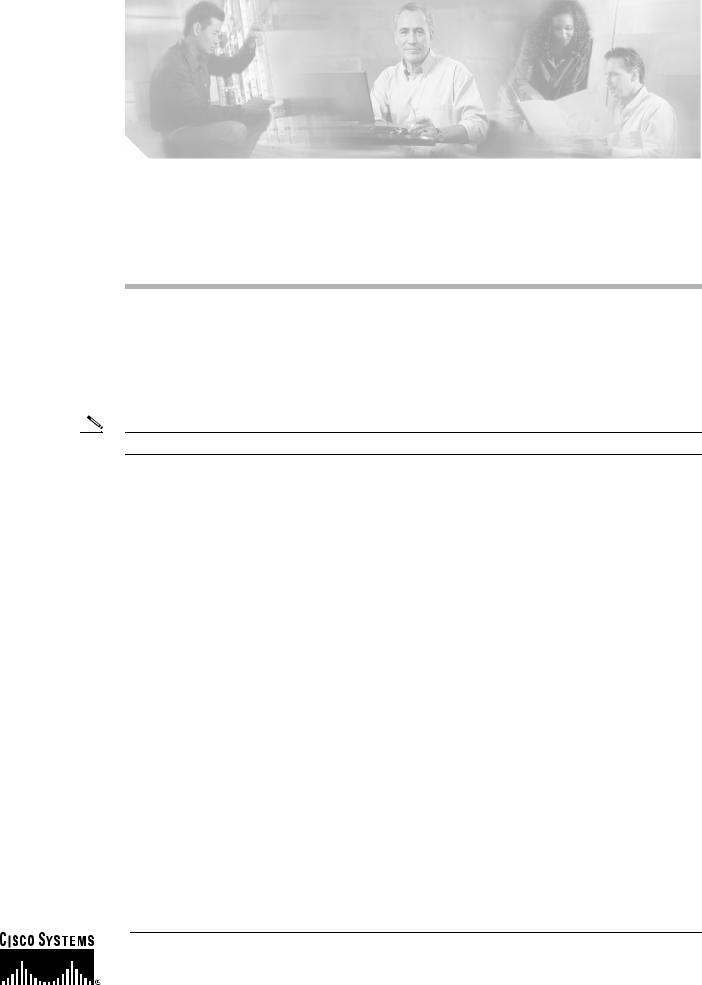Cisco Systems 2820, 1900 User Manual

Release Notes for the Catalyst 1900 and Catalyst 2820 Series Switches, Version 9.00.06
July, 2002
These release notes provide information on the Catalyst 1900 and Catalyst 2820 series Ethernet switches (hereafter referred to as the Catalyst 1900 switches and the Catalyst 2820 switches) using standard and Enterprise Edition firmware version 9.00.06.
Note This document describes the problems that are resolved in versions 9.00.00 through 9.00.06.
Contents
This document has these sections:
•“Using Previous Releases of the Switch Firmware” section on page 2
•“Supported Browsers” section on page 2
•“Features” section on page 3
•“Limitations” section on page 4
•“Usage Guidelines” section on page 4
•“Caveats” section on page 7
•“Related Documentation” section on page 13
•“Obtaining Documentation” section on page 13
•“Obtaining Technical Assistance” section on page 14
The tracking numbers for some items in this document are added for your convenience.
Corporate Headquarters:
Cisco Systems, Inc., 170 West Tasman Drive, San Jose, CA 95134-1706 USA
Copyright © 2002. Cisco Systems, Inc. All rights reserved.

Using Previous Releases of the Switch Firmware
Using Previous Releases of the Switch Firmware
The Catalyst 1900 and Catalyst 2820 switches are shipped with firmware version 9.00.05. Depending on the board version of your switch, you need the minimum firmware releases listed in Table 1.
The “System Revision” field on the System Configuration menu displays the board revision of your switch. When you use the show version command from the command-line interface (CLI), the “Hardware Board Revision Is” field displays the board revision.
The Firmware Configuration Menu and the Console and Upgrade Configuration page display the firmware version in use.
Table 1 |
Supported Firmware on the Catalyst 1900 and Catalyst 2820 Switches |
|||
|
|
|
|
|
Board |
|
|
|
|
Revision |
|
Switch |
Supported Firmware Version |
|
|
|
|
|
|
1 |
|
Catalyst 1900-A |
6.x or later |
|
|
|
Catalyst 1900-EN |
|
|
|
|
|
|
|
1 |
|
Catalyst 2820-A |
6.x or later |
|
|
|
Catalyst 2820-EN |
|
|
|
|
|
|
|
4 |
|
Catalyst 1900-A |
8.00.04 or later |
|
|
|
Catalyst 1900-EN |
|
|
|
|
|
|
|
5 |
|
Catalyst 1900-A |
8.01.00 or later |
|
|
|
Catalyst 1900-EN |
|
|
|
|
|
|
|
5 |
|
Catalyst 2820-A |
8.01.01 or later |
|
|
|
Catalyst 2820-EN |
|
|
|
|
|
|
|
Supported Browsers
To use the Catalyst 1900 or Catalyst 2820 Switch Manager, you must have one of these web browsers installed on your management station:
Table 2 |
Browser Support for Web-Based Management |
|
|
|
|
|
|
Browser |
|
Minimum Version |
Supported Version |
|
|
|
|
Netscape Communicator |
4.5 |
4.5, 4.51, 4.61 |
|
|
|
|
|
Microsoft Internet Explorer |
4.01a |
4.01a, 5.0 |
|
|
|
|
|
Note Netscape Communicator 4.60 is not a supported browser. Microsoft Internet Explorer is not a supported browser on Solaris 2.5.1 or later operating systems.
For information about configuring your browsers, refer to the Catalyst 1900 Series Installation and Configuration Guide and the Catalyst 2820 Series Installation and Configuration Guide.
Release Notes for the Catalyst 1900 and Catalyst 2820 Series Switches, Version 9.00.06
2 |
OL-2901-01 |
|
|

Features
Features
The Catalyst 1900 and 2820 switches running firmware version 9.00.00 and above have these features:
•Cluster membership capability—The Catalyst 1900 and Catalyst 2820 switches can be added to switch clusters and managed by a Catalyst 2900 XL or a Catalyst 3500 XL command switch by meeting these requirements:
–The Catalyst 2900 XL or Catalyst 3500 XL command switch must be running IOS software Release 12.0(5)XP or later and must have an IP address assigned.
–The Catalyst 1900 or Catalyst 2820 switch must be running firmware version 9.x or later.
–The Catalyst 1900 or Catalyst 2820 switch must be Cisco Discovery Protocol (CDP) version 2-enabled.
–The Catalyst 1900 or Catalyst 2820 switch must be connected to a cluster member or to a command switch port that belongs to the management VLAN on the command switch.
•Encrypted (secret) passwords—You can assign encrypted privilegedand user-level passwords to the switch. An encrypted password can have 1 to 25 characters, including spaces and punctuation. Encrypted passwords are case sensitive.
•Secured access to management interfaces—At initial setup, you can assign a switch IP address and an unencrypted privileged-level password to the switch. You must assign a privileged password, encrypted or unencrypted, to the switch to access the Catalyst 1900 or Catalyst 2820 switch manager and to Telnet to the switch.
•Security enhancement to password recovery—On previous releases of the firmware, you could view the password from the diagnostic console, which posed a security threat to networks that used the same password for other devices in the network. When using the diagnostic console, you can now clear the switch password only if you have lost or forgotten it.
•Additional SNMP community strings—You can assign up to four read and four write community strings from the Catalyst 1900 or Catalyst 2820 switch manager.
•Clear addresses on link down—You can enable a secured switch port to remove its address associations when the port loses its link.
•TFTP Put option disabled by default—To prevent unauthorized upgrades, the Accept Upgrade Transfer from Other Hosts option default setting is disabled.
•Increased RMON history tables—The switch supports a maximum of 540 RMON history tables. However, previous releases of the firmware only supported up to 20 RMON history tables for each switch port. You can now allocate the 540 history tables among all switch ports, in any combination. For example, you can allocate 540 history tables to one switch port, or you can allocate 20 history tables among 27 ports.
•Cisco Group Management Protocol (CGMP) Fast Leave—This option enables the switch port to leave an IP multicast group immediately when all the members have left the multicast group.
•Message-of-the-day banner—From the CLI, you can create a 400-character (or 20-line) message, which appears before the management console login screen appears.
Release Notes for the Catalyst 1900 and Catalyst 2820 Series Switches, Version 9.00.06
|
OL-2901-01 |
3 |
|
|
|

Limitations
Limitations
These sections provide usage limitations for the switches.
Limitation Specific to the Catalyst 2820 Switches
After removing or inserting a module, click Reload to display a fresh switch image on the Home page.
Limitations for the Catalyst 1900 and Catalyst 2820 Switches
•Clicking Reload from any switch manager page displays a fresh copy of the Home page, not the currently displayed page.
•The switch manager does not check parameter values that are outside the value range. If you enter an invalid parameter value, the switch manager redisplays the switch manager page with the original value. Parameter value ranges are provided in the management console, the switch manager online help, and the Catalyst 1900 Series Installation and Configuration Guide and the Catalyst 2820 Series Installation and Configuration Guide.
•RMON statistics gathering has these maximum limits:
–27 rows in these tables: etherStatsTable, historyControlTable, alarmTable, and eventTable.
–If you are logging events, you can have ten entries per event, and the list is circular.
Usage Guidelines
These sections provide usage guidelines for the switches:
•“Usage Guidelines Specific to the Catalyst 1900 Switches” section on page 4
•“Usage Guidelines Specific to the Catalyst 2820 Switches” section on page 5
•“Usage Guidelines for the Catalyst 1900 and Catalyst 2820 Switches” section on page 5
Usage Guidelines Specific to the Catalyst 1900 Switches
This section describes usage guidelines specific to the Catalyst 1900 switches.
•Some switches are shipped with screws installed in the top rack-mounting holes closest to the front panel. If you want to rack-mount the switch with the front panel forward, remove these screws before attaching the mounting brackets. Do not use these screws to attach the mounting brackets to the switch. Use the screws supplied with the brackets. For information on attaching the mounting brackets to the switch, refer to the Catalyst 1900 Series Installation and Configuration Guide.
•If you connect to the switch attachment unit interface (AUI) port, you might notice that the fan in the switch slows down. This does not affect the operation of the switch.
•If there is no link after you connect an MT-RJ fiber-optic port on a WS-C1924F-A or a WS-C1924F-EN switch to an SC port on a 100BASE-FX-compatible device, the polarity of the SC connectors on the MT-RJ patch cable and the SC port on the device might not match. Remove the SC connectors from the snap-on holder on the cable, and transpose the connectors for A and B.
Release Notes for the Catalyst 1900 and Catalyst 2820 Series Switches, Version 9.00.06
4 |
OL-2901-01 |
|
|

Usage Guidelines
•If you connect an autonegotiating 100BASE-TX port of a Catalyst 1900 switch to a device that does not autonegotiate, there could be problems establishing a link. To work around this problem, configure the switch port to either half or full duplex to match the configuration of the other device.
Usage Guidelines Specific to the Catalyst 2820 Switches
This section describes usage guidelines specific to the Catalyst 2820 switches.
•If your attempt to upgrade the ATM module firmware fails while the module is operating normally, the expansion slot LED on the switch turns amber. The module continues operation, but the module image in Flash memory is corrupted. When you reset the ATM module, it will not find a valid Cisco IOS image, and the ATM module will not pass the power-on self-test (POST). To correct this problem, repeat the firmware upgrade procedure to download a new firmware image on the ATM module.
•If you connect an autonegotiating 100BASE-TX switch module port of a Catalyst 2820 switch to a device that does not autonegotiate, there could be problems establishing a link. To work around this problem, configure the module port for either half or full duplex to match the configuration of the other device.
Usage Guidelines for the Catalyst 1900 and Catalyst 2820 Switches
This section describes usage guidelines that apply to both the Catalyst 1900 and Catalyst 2820 switches.
•The RJ-45-to-DB-9 female DTE (labeled PC) adapter is now the only adapter that ships with the Catalyst 1900 and Catalyst 2820 switches. You can order a kit (part number ACS-DSBUASYN=) containing the RJ-45-to-DB-25 female DTE adapter and RJ-45-to-DB-25 male DCE adapters from Cisco.
•The DOS diskette containing the switch firmware and device-specific MIBs is no longer shipped with the switch. You can download the latest switch firmware and MIBs from the Service and Support site on Cisco.com. For information about Cisco.com, see the “Cisco.com” section on page 15.
•Be sure that JavaScript is enabled. From Netscape Communicator 4.xx, select
Edit > Preferences > Advanced > Enable JavaScript. JavaScript is enabled by default on Microsoft Internet Explorer.
•Be sure that the switch manager page is updated whenever you visit the page. Set the caching of pages to Every time on Netscape Communicator or Once per session on Microsoft Internet Explorer.
•You can bookmark the switch IP address to easily retrieve the switch manager for later use.
–If you are using Netscape Communicator, choose the Communicator menu option, and select
Bookmarks > Add Bookmark.
–If you are using Microsoft Internet Explorer, choose the Favorites menu option, and select Add to Favorites.
Do not use the right mouse-button to bookmark the switch IP address; doing so only saves the specific frame (image) of the switch manager page.
Release Notes for the Catalyst 1900 and Catalyst 2820 Series Switches, Version 9.00.06
|
OL-2901-01 |
5 |
|
|
|
